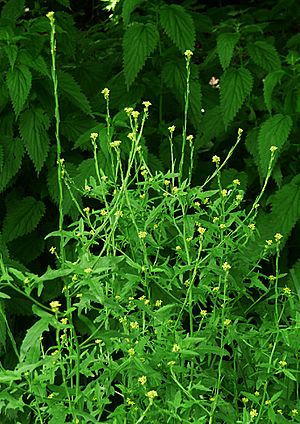Hedge mustard facts for kids
Quick facts for kids Hedge-mustard |
|
|---|---|
 |
|
| Scientific classification | |
| Genus: |
Sisymbrium
|
| Species: |
officinale
|
| Synonyms | |
|
Erysimum officinale L. |
|
Sisymbrium officinale, also known as the hedge mustard, is a common plant. It belongs to the Brassicaceae family, which includes plants like cabbage and broccoli. You can often spot it growing by roadsides or in open fields.
Contents
What Does Hedge Mustard Look Like?
Hedge mustard can grow quite tall, up to 80 centimeters (about 31 inches) high. It has straight stems that stand upright. Its small yellow flowers are about 4 millimeters wide.
The leaves at the bottom of the plant are wide. They have two or three smaller parts, called lobes, on their sides. After the flowers, the plant grows long, thin fruits. These fruits are pressed close to the stem. When they are young, they are smooth. As they get older, they might become a bit hairy.
Hedge Mustard vs. Other Mustards
Hedge mustard is different from the mustard plants you might know. Those belong to a different group called Brassica. While hedge mustard looks similar to other plants in its own group, Sisymbrium, it stands out. Its flowers and fruits are packed tightly along the stem. Other Sisymbrium plants usually have fruits that hang more freely.
Who Eats Hedge Mustard?
Some caterpillars love to munch on hedge mustard leaves. For example, the caterpillars of the small white butterfly (Pieris rapae) often eat this plant.
Where Does Hedge Mustard Grow?
Hedge mustard is originally from Europe and North Africa. But now, you can find it all over the world! It grows well in many places.
In the United Kingdom, you can find it in Ireland, Wales, and England. However, it is not common in Scotland. It often grows by roadsides, in empty lots, or as a weed in farm fields.
How People Use Hedge Mustard
Hedge Mustard as Food
People in Europe have grown hedge mustard for a long time. They use its leaves and seeds for food. The leaves have a slightly bitter taste, a bit like cabbage. You can eat them in salads or cook them like other leaf vegetables.
The seeds of hedge mustard have also been used. In Europe, people made them into mustard pastes. This is similar to how other mustard seeds are used today.
Hedge Mustard in Traditional Medicine
For many years, people have used hedge mustard in traditional medicine. The ancient Greeks believed it could protect against all kinds of poisons.
In folk medicine, it was often used to help with sore throats. Because of this, it earned the nickname singer's plant. People believed it was a great remedy for losing your voice. A famous French writer, Jean Racine, even suggested using a syrup made from it to cure voicelessness.
People also thought it was good for chest and lung problems. They believed it could help with coughs, wheezing, and shortness of breath. The seeds were also thought to be a special remedy against poisons. Herbalists today still use the juice and flowers for various issues. These include bronchitis (a type of chest cold) and stomach problems. It is also seen as something that can help you feel more energetic. In Tibetan medicine, it is used to help with symptoms of food poisoning.
See also
 In Spanish: Erísimo para niños
In Spanish: Erísimo para niños

